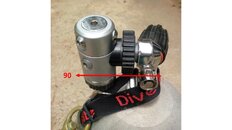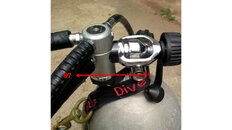Nope. Hardly any price difference between a new Yoke-only valve and a DIN valve that accepts Yoke plugs. In fact, many new cylinders come with a DIN/Yoke valve even in the USA (particularly steel cylinders). Also, I can't think of any good reason why people would be dropping/bending DIN valves more often than Yoke valves. Then again, 90% of all "bent valves" are really just a bent or broken valve handle, which is easily replaceable without the need to buy a new valve.
OK let me spoon feed you. You don't have to replace the yoke valve when it is somewhat bent/deformed. It still works most of the time. I had a couple tanks in Bonaire where you couldn't get your yoke (adapter in my case) on it square because it was bent too much. I had to deal with a stream of champagne bubbles on that dive. Learned not to take tanks like that from the fill station and keep an extra in the truck. If the same damage occurred to a DIN valve, you would not be able to screw a reg into it anymore. If there was a plug in it, it would likely be jammed in place. All of the damage I noted was to the head of the valve, nothing to do with the handle. With damage I saw, an operator would have to replace all of the damaged valves if they were DIN that were still useable with yoke. That is your cost increase.
Yes, people wouldn't drop DIN tanks more than yoke tanks, but that is not the issue. The issue is they are rental tanks and people treat them poorly because you just drop them off back in a pile of tanks when you are done with no recourse for damage.
At home ALL of our tanks/regs are DIN, and I personally would never buy a yoke only valve. But I am not lending them out to people who throw them in the back of trucks and treat them generally poorly.
We have no issue with using the DIN to yoke adapters in Bonaire, as the ones we use definitely don't stick out 5cm, and aren't really headbangers. If they didn't work well we'd simply spend a few minutes at home before our trip and switch the reg to yoke. Not a big deal whatsoever.






